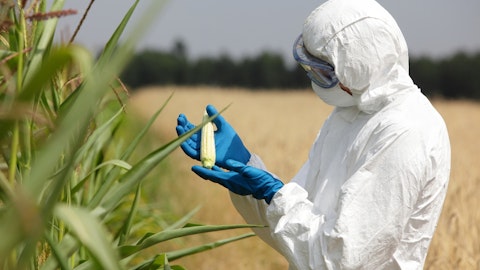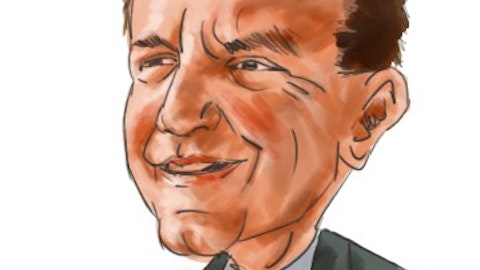Shankar Musunuri: No. Actually, we stated Nicotine will start first half of next year. We are constructing CGMP manufacturing facility, and that will be complete by the end of this year.
Jonathan Aschoff: Okay. And can you give us a little more clarity on how much is left on the ATM as of today?
Jessica Crespo: Yes. So as part of our, I would say, general corporate housekeeping, we’ve canceled the ATM in connection with converting our automatic shelf into a regular shelf. So you’ll see those filings come through today. So we’ll put the ATM back up when and if it’s appropriate for the appropriate amount. So at this point, it’s in capital.
Jonathan Aschoff: Okay. But can you tell us how much of that ATM was actually used overall from the core and in it?
Jessica Crespo: Yes. Under that ATM, we’ve sold approximately $14 million in terms of gross proceeds, and we’ve netted about $13.6 million.
Jonathan Aschoff: Yes, that is all.
Operator: Your next question comes from the line of Robert LeBoyer with Noble Capital Markets.
Robert LeBoyer: Thank you for laying out some of the milestones for the COVAXIN programs. Could you give any time frames for€“- well, you had mentioned the midyear top line or conclusions in full data. Could you give some of the time frames for the Phase III and some of the other program starts and milestones?
Shankar Musunuri: Robert, are you specifically referring to COVAXIN or other programs.
Shankar Musunuri: Are you referring to co vaccine and other programs?
Robert LeBoyer: Yes.
Shankar Musunuri: As I stated before, Yes. The vaccine, we are finishing up the current study, and we’ll have the final data analysis expecting midyear this year. And as I stated before, we may need to do a safety clinical trial. We’re still waiting for BA to respond their comments on our safety protocol. And once we get that, obviously, we — as we stated, we are seeking government funds to conduct the clinical trial. So as far as other Phase III clinical trials are concerned, there are 2 more we talked about during this earnings call. One of them is our signature ARK400 modified gene therapy platform. So where we have completed recruitment in our retinitis pigmentosa portion of the Phase I/II clinical trial. And so based on data read, we’re anticipating midyear on efficacy signal.
And we’re going to get into — planning to get into Phase III by the end of this year for RQ400 gene therapy Phase III clinical trial. And the second Phase III clinical trial is related to NeoCart, our cell therapy platform, — and the rate limiting for that is €“ it’s a colo-cell therapy. It’s almost like a personalized medicine. So we are building our own manufacturing facilities, runway in the existing facilities to convert them into cGMP manufacturing for cell therapy production. And we’re anticipating that construction will be complete by the end of the year, and that will allow us to initiate Phase III clinical trial in the first half of 2024.
Operator: Your next question will come from the line of Sean Lee with H.C. Wainwright.
Sean Lee: Just a quick question from me. So for the proposed new CAR study, have you finalized on the endpoint in the study design yet?
Shankar Musunuri: Yes. I think the study design, as we agreed with the DA includes chondroplasty as a control, and that’s different than prior control they used in the prior studies. The second thing is the endpoints will include pain and function.
Sean Lee: Compared to the previous Phase III that histogenics ramp with NeoCart, what would be the key differences?
Shankar Musunuri: The key differences are — they had a microfracture control, which is — I mean, so what we did is we looked into the current standard of care, which is chondroplasty. And so based on that, we actually wanted to use chondroplasty and FDA is that. The second thing is we’re also going to restrict the lesion size to the 3 Centimeter Square and really focus on that so that it’s not very broad like they did before. So I think with these changes, we anticipate we’ll have better prospects of relatively easily recruiting patients. That’s important because chondroplasty is standard of care, not for microfracture. And that’s really important. That’s an important change. And also focusing on a specific range for lesion size is very important for us.
Sean Lee: Great. One last final follow-up on that. For the new manufacturing facility that you’re building, would that be only for supporting materials for the Phase III? Or could you scale that up to potential commercial later as well?
Shankar Musunuri: Good questions, Sam. When we build this personalized medicine, many cell therapies, this is like a scale-out mark scale-up. So these are very small — you can call them bioreactors. We call them tissue-engineer process units hep. So these things are very small suites. So this can be used for commercial manufacturing to…
Sean Lee: I see. That’s all the questions I have.
Operator: Your next question will come from the line of Daniil Gataulin with Chardan.



